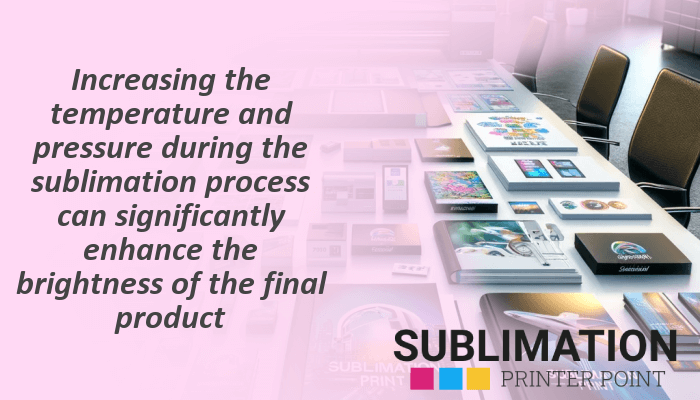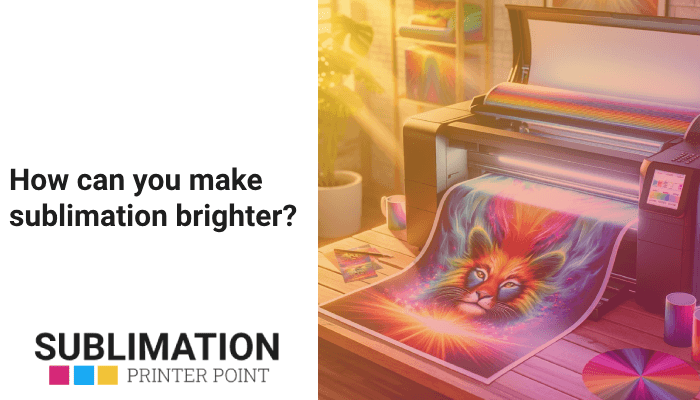Learn the tricks of producing prints that are brighter and more colorful with sublimation printing techniques. This thorough guide covers several aspects of print brightness enhancement, including heat transfer, fabric type, and sublimation ink.
To produce colorful, bright prints, sublimation printing is a complicated procedure that takes into account a number of variables. Important factors include high-resolution photos, careful temperature management, high-quality sublimation ink and paper, and the kind of cloth used. Print brightness can also be greatly increased by using pre-treatment treatments, picture editing tools, and efficient color management. Finally, the brilliance of the prints can also be influenced by the printing speed.
- Sublimation ink quality directly impacts color intensity and vibrancy.
- Heat transfer and temperature control are critical in the dye-sublimation process.
- High-quality sublimation paper ensures consistent color distribution.
- Fabrics with high polyester content are ideal for sublimation printing.
- Image resolution significantly influences the brightness of prints.
- Effective color management and the use of image editing software can enhance print brightness.
- Pre-treatment solutions improve fabric’s ability to absorb sublimation ink.
- Printing speed can affect the brightness of sublimation prints.
What is the role of sublimation ink in achieving brighter prints?
The use of sublimation ink is essential for improving print brightness. This specialist ink, like Hiipoo Sublimation Ink, is made to sublimate—transform from a solid to a gas without going through a liquid phase. Because of this special quality, the ink can penetrate the print material’s surface and produce colors that are vivid and durable. Brighter prints are mostly dependent on the quality of the sublimation ink, which has a direct impact on the finished print’s color vibrancy and intensity.
How does the quality of sublimation ink impact color saturation?
Color saturation is greatly impacted by the quality of sublimation ink. Richer and more vibrant colors are produced by using high-quality inks, such as Epson’s SureColor F570 Pro, which have finely ground pigments to provide a larger color range. On the other hand, because of their low pigment quality and irregular ink flow, low-quality inks can produce prints that are lifeless and faded. Consequently, one guaranteed method to increase sublimation color intensity is to invest in high-quality sublimation ink.
What are the best practices for color management in sublimation printing?
Precise parameters and superior materials are required for effective color management in sublimation printing. It is crucial to use an appropriate ICC profile to guarantee that colors are correctly translated from the source image to the printer. Furthermore, color shifts can be avoided and optimal print quality can be maintained with routine printer maintenance, which includes cleaning and calibration. Finally, you can further improve sublimation brightness by adjusting saturation and color balance using picture editing tools.
The Epson SureColor F570 Pro is a 24-inch desktop sublimation printer that is perfect for creating prints with excellent quality, as you may not be aware. It makes use of premium sublimation ink, which produces richer, more saturated colors by offering a wider color range.
How does the dye-sublimation process affect the brightness of prints?
The brightness of prints is significantly impacted by the dye-sublimation process. Sublimation ink is heated in this method to turn it into a gas, which seeps into the print medium and solidifies into brilliant, long-lasting color. The final print’s brightness and color saturation can be strongly influenced by the heat’s strength and the length of the sublimation process. To maximize the brightness of sublimation prints, one must so fully understand the nuances of the dye-sublimation process.
How does heat transfer influence the brightness in sublimation printing?
The brightness and vibrancy of prints are directly impacted by heat transfer, which is an essential component of sublimation printing. The sublimation ink becomes gaseous due to the heat, which enables it to seep into the print medium. Dull and faded prints could result from the ink not fully sublimating if the heat is applied too low. On the other hand, too much heat can make colors bleed or get too saturated. Thus, the secret to improving sublimation brightness is to maintain the proper temperature.
What is the impact of temperature control on the dye-sublimation process?
An essential component of the dye-sublimation process is temperature control. The sublimation ink needs to evaporate at a temperature that is high enough to do so, but not so high as to harm the print medium or distort color. Bright, colorful prints are produced when the ink completely sublimates and penetrates the print material, which is ensured by precise temperature control and timing. Therefore, raising the brightness of the sublimation color requires careful temperature management.
What is the importance of sublimation paper in creating brighter prints?
Brighter prints are primarily produced using sublimation paper. This particular paper is made to retain sublimation ink and, when heated, release it uniformly, guaranteeing even color distribution. The final print’s brightness and color saturation can be significantly impacted by the sublimation paper’s quality. Better sublimation paper, like TeckWrap Craft, has a greater capacity to absorb and release ink, resulting in prints that are more vivid and dazzling.
Use high-resolution photos for brighter sublimation printing. Prints with higher resolutions will have greater vibrancy and brightness since they contain more color information and detail. Prints with poor resolution can be lifeless and lacking in detail.
How does the quality of sublimation paper affect print quality?
Print quality is directly impacted by the sublimation paper’s quality. Better sublimation paper produces prints that are more vivid and brighter because it can hold more ink and release it more evenly when heated. Poor-quality paper, on the other hand, might not release the ink uniformly, producing uneven and spotty prints. To increase dye-sublimation vibrancy, it is wise to invest in premium sublimation paper.
What role does image resolution play in the brightness of sublimation prints?
The brightness of sublimation prints is significantly influenced by image resolution. Prints with higher resolutions will have greater vibrancy and brightness since they contain more color information and detail. On the other hand, prints with poor resolution could be lifeless and lacking in detail. Consequently, one useful method for enhancing sublimation colors and producing brighter sublimation printing is to use high-resolution photos.
How does the type of fabric influence the brightness of sublimation prints?
The brightness of the prints produced by sublimation printing can be significantly influenced by the type of fabric used. High-polyester fabrics—like some cotton varieties—are perfect for sublimation printing because they can tolerate high temperatures and effectively absorb sublimation ink. This produces prints that are vivid, brilliant, and fade-resistant. To increase the vibrancy of the color sublimation, it is imperative to select the appropriate cloth.
What fabric types are best suited for bright sublimation prints?
Vibrant sublimation prints work better on some types of cloth. Microfiber and other high-polyester fabrics work best because they can absorb more sublimation ink and produce prints that are brighter. Additionally, because they allow for higher ink penetration, textiles with a smooth, tight weave, like satin, can yield prints that are sharper and more colorful. As a result, the brightness of sublimation prints can be greatly affected by the type of fabric utilized.
How does sublimation coating on fabrics affect the brightness of prints?
The brightness of prints on textiles can be significantly impacted by sublimation coating. With the help of this unique coating, the fabric will be better able to absorb sublimation ink, producing patterns that are more vivid and brighter. Long-lasting brightness is ensured by the coating, which also aids in preventing fading of the print. Consequently, a useful method to improve sublimation color brightness is to use materials that have been coated with sublimation ink.
What are the key printing techniques to enhance the brightness in sublimation printing?
The brightness of sublimation printing can be improved using a number of important printing techniques. These consist of employing premium sublimation paper and ink, precisely controlling the sublimation process’s temperature, and utilizing high-resolution photos. Pre-treatment solutions can also increase the fabric’s capacity to absorb sublimation ink, which will produce prints that are more vibrant. The brightness of the prints can also be affected by changing the printing speed; slower rates typically result in more vivid colors.

How does the use of image editing software contribute to brighter prints?
For brighter prints, the use of image editing software can make a big difference. You can precisely regulate saturation, contrast, and color balance with software like Adobe Photoshop, which makes it possible to prepare your photos for sublimation printing. You may boost the brightness and vibrancy of your prints by modifying these settings, which makes image editing software an important tool in the hunt for better sublimation brightness.
What is the role of pre-treatment solutions in enhancing print brightness?
The use of pre-treatment solutions is essential for improving print brightness. These solutions increase the fabric’s capacity to absorb sublimation ink, readying it for sublimation printing. Prints produced as a result are more vivid and brighter. Pre-treatment products can also aid in preventing color fading and bleeding, guaranteeing brightness that lasts. Therefore, a useful method of increasing sublimation color intensity is to use pre-treatment solutions.
How does printing speed affect the brightness of sublimation prints?
Sublimation print brightness can be significantly influenced by printing speed. Brighter, more vivid colors are produced when printing at slower rates because the sublimation ink has more time to penetrate the print medium. On the other hand, as the ink has less time to sublimate, quicker printing speeds could provide less colorful prints. Thus, one useful method to maximize the brightness of sublimation prints is to change the printing speed.

